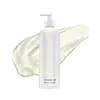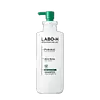What's inside
What's inside
 Key Ingredients
Key Ingredients

 Benefits
Benefits

 Concerns
Concerns

 Ingredients Side-by-side
Ingredients Side-by-side

Water
Skin ConditioningSodium C14-16 Olefin Sulfonate
CleansingLauryl Glucoside
CleansingDecyl Glucoside
CleansingCocamide Mipa
EmulsifyingSaccharomyces Cerevisiae Extract
Skin ConditioningCaffeine
Skin ConditioningPanthenol
Skin ConditioningNiacinamide
SmoothingSalicylic Acid
Masking1,2-Hexanediol
Skin ConditioningPolyquaternium-22
Glyceryl Caprylate
EmollientPolyquaternium-10
Caprylyl Glycol
EmollientCitric Acid
BufferingParfum
MaskingLinalool
PerfumingLimonene
PerfumingWater, Sodium C14-16 Olefin Sulfonate, Lauryl Glucoside, Decyl Glucoside, Cocamide Mipa, Saccharomyces Cerevisiae Extract, Caffeine, Panthenol, Niacinamide, Salicylic Acid, 1,2-Hexanediol, Polyquaternium-22, Glyceryl Caprylate, Polyquaternium-10, Caprylyl Glycol, Citric Acid, Parfum, Linalool, Limonene
Water
Skin ConditioningSodium Cocoyl Isethionate
CleansingDisodium Laureth Sulfosuccinate
CleansingLauryl Betaine
CleansingGlyceryl Stearate
EmollientTrihydroxystearin
Skin ConditioningPolyquaternium-10
Caffeine
Skin ConditioningCetyl Alcohol
EmollientDicaprylyl Ether
EmollientSodium Benzoate
MaskingSodium Salicylate
PreservativeMentha Piperita Oil
MaskingMenthol
MaskingCitric Acid
BufferingCaprylic/Capric Triglyceride
MaskingCaprylyl Glycol
EmollientIllicium Verum Fruit/Seed Oil
MaskingRosmarinus Officinalis Leaf Oil
MaskingDextrin
AbsorbentJuniperus Virginiana Oil
MaskingTetrasodium EDTA
Mentha Arvensis Leaf Oil
MaskingEucalyptus Globulus Leaf Oil
PerfumingOcimum Basilicum Oil
MaskingAnthemis Nobilis Flower Oil
MaskingViola Odorata Leaf Extract
MaskingLactobacillus Ferment Lysate
Skin ConditioningGlycerin
HumectantCamellia Sinensis Seed Extract
HumectantTocopherol
AntioxidantCeramide NP
Skin ConditioningHydrogenated Lecithin
EmulsifyingPhytosphingosine
Skin ConditioningBiotin
AntiseborrhoeicWater, Sodium Cocoyl Isethionate, Disodium Laureth Sulfosuccinate, Lauryl Betaine, Glyceryl Stearate, Trihydroxystearin, Polyquaternium-10, Caffeine, Cetyl Alcohol, Dicaprylyl Ether, Sodium Benzoate, Sodium Salicylate, Mentha Piperita Oil, Menthol, Citric Acid, Caprylic/Capric Triglyceride, Caprylyl Glycol, Illicium Verum Fruit/Seed Oil, Rosmarinus Officinalis Leaf Oil, Dextrin, Juniperus Virginiana Oil, Tetrasodium EDTA, Mentha Arvensis Leaf Oil, Eucalyptus Globulus Leaf Oil, Ocimum Basilicum Oil, Anthemis Nobilis Flower Oil, Viola Odorata Leaf Extract, Lactobacillus Ferment Lysate, Glycerin, Camellia Sinensis Seed Extract, Tocopherol, Ceramide NP, Hydrogenated Lecithin, Phytosphingosine, Biotin
Ingredients Explained
These ingredients are found in both products.
Ingredients higher up in an ingredient list are typically present in a larger amount.
Caffeine is most associated with coffee, tea, and cacao. In skincare, it helps with calming inflammation and is rich in antioxidants.
While caffeine is used to treat cellulite and and dark circles, further studies are needed to prove this. It has been believed to help with these skin conditions due to its ability to dilate blood vessels and increase blood flow.
Some studies are looking into caffeine's ability to protect against UV rays.
Learn more about CaffeineCaprylyl Glycol is a humectant and emollient, meaning it attracts and preserves moisture.
It is a common ingredient in many products, especially those designed to hydrate skin. The primary benefits are retaining moisture, skin softening, and promoting a healthy skin barrier.
Though Caprylyl Glycol is an alcohol derived from fatty acids, it is not the kind that can dry out skin.
This ingredient is also used as a preservative to extend the life of products. It has slight antimicrobial properties.
Learn more about Caprylyl GlycolCitric Acid is an alpha hydroxy acid (AHA) naturally found in citrus fruits like oranges, lemons, and limes.
Like other AHAs, citric acid can exfoliate skin by breaking down the bonds that hold dead skin cells together. This helps reveal smoother and brighter skin underneath.
However, this exfoliating effect only happens at high concentrations (20%) which can be hard to find in cosmetic products.
Due to this, citric acid is usually included in small amounts as a pH adjuster. This helps keep products slightly more acidic and compatible with skin's natural pH.
In skincare formulas, citric acid can:
While it can provide some skin benefits, research shows lactic acid and glycolic acid are generally more effective and less irritating exfoliants.
Most citric acid used in skincare today is made by fermenting sugars (usually from molasses). This synthetic version is identical to the natural citrus form but easier to stabilize and use in formulations.
Read more about some other popular AHA's here:
Learn more about Citric AcidPolyquaternium-10 is an ammonium salt of hydroxyethylcellulose. It is a white and granular powder used as a film-former and anti-static agent.
This ingredient is commonly found in hair conditioning products. According to a manufacturer, its positive charge makes it great for absorbing hair proteins. The manufacturer also states this ingredient helps with curl retention.
For haircare friends: this ingredient is not a silicone.
Learn more about Polyquaternium-10Water. It's the most common cosmetic ingredient of all. You'll usually see it at the top of ingredient lists, meaning that it makes up the largest part of the product.
So why is it so popular? Water most often acts as a solvent - this means that it helps dissolve other ingredients into the formulation.
You'll also recognize water as that liquid we all need to stay alive. If you see this, drink a glass of water. Stay hydrated!
Learn more about Water